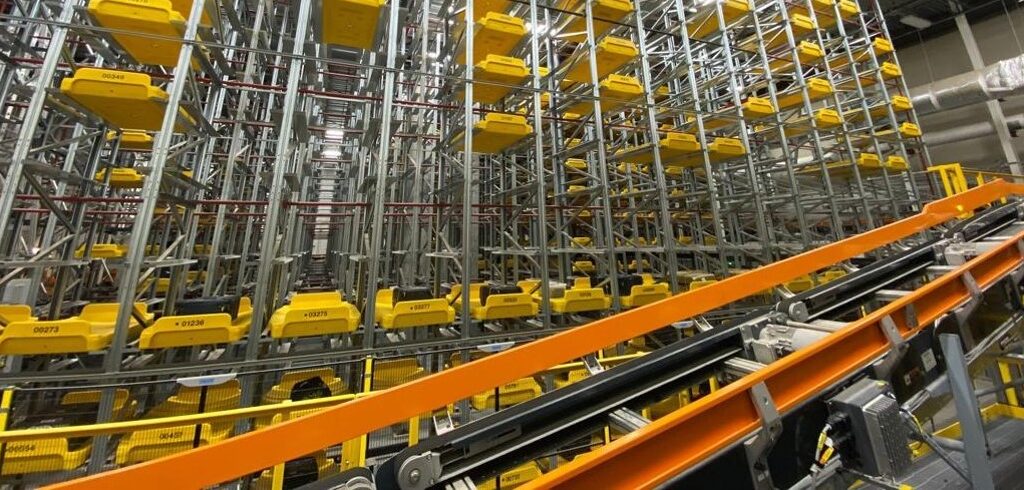Orlando International Airport in Florida has begun installing the final technologies in its new South Terminal Complex (STC) ahead of its opening in summer 2022.
According to the airport, the STC project is approximately 90% complete, with the installation of the baggage handling system, interactive media displays and visual docking guidance system expected to be completed in late spring, with ORAT trials taking place in early summer. However, no official opening date has been announced yet.
The baggage handling system arriving at the STC includes revolving carousels on the level that passengers disembark on. The baggage will be transported from the ground level to the top level using a tote system that has more vertical circulation than a traditional, gravity-limited conveyor-belt system.
The bag tags will be synced to an RFID chip embedded in the tote, which tracks the bags and reduces baggage jams. The RFID technology creates less noise than a traditional system. It can run approximately 99% uptime and reroute totes and baggage around areas closed for maintenance. The system is augmented by a robotics-controlled early bag storage facility with capacity for approximately 1,800 bags.
Throughout the STC, a system of approximately 1,000 dynamic, network-connected display monitors will provide a stream of targeted messaging. At the ticket counter, displays will adjust between airlines, displaying flight information relevant to that hour’s travelers. As passengers move to the TSA checkpoint, the queue management system (QMS) will monitor security lines and display waiting times and security-clearance updates. When travelers reach the terminal, signs will direct them to terminal amenities and gates, while updating on any gate or emergency changes. Displays can show information such as arrival airport weather forecasts, and construction or traffic updates.
Bluetooth wayfinding beacons will work with wireless access points to provide location-specific guidance. By fine-tuning the location information, the airport hopes to more easily direct passengers to its commercial offerings. The beacons communicate with users’ smartphones, tracking passenger movements to provide detailed, turn-by-turn digital navigation.
The STC will also feature a set of interactive video displays, known as the Experiential Media Environment (EME), which include film, audio, computer graphics and AI-generated artwork of Florida. The first of the three elements of the EME is The Portal, a three-story gateway in the arrival hall with 32 curved screens suspended in a helical frame. Synchronized 12K content in loops of 125 minutes will play on the interior and exterior screens.
The second EME element is called Windows on Orlando and consists of three side-by-side panoramic screens that are 10m high and 30m long. Central Florida locations, such as NASA’s Kennedy Space Center, will feature over its repeating 79-minute runtime. The Moment Vault in the airside hub will be a 360° immersive surround experience with 2mm displays on a 15K digital canvas that places visitors within the scenes. Highlights in the display’s 109-minute loop include visits to Mars and virtual swims with bioluminescent fish.
The airport’s operator, Greater Orlando Aviation Authority (GOAA), has ensured the interchangeable use of ticket counter displays among airlines to enable changes between ticketing assignments in the ticketing hall or at boarding gates. For international flights, 100% facial recognition will be used for arrivals and departures. The self-boarding e-gates will use facial-recognition cameras to avoid wait times.
A visual docking guidance system (VDGS) implemented across 22 gates will enable pilots to park aircraft themselves, limiting instances of passengers waiting on the apron to disembark. Laser-scanning technology will capture and track aircraft movements, providing pilots with real-time navigation that offers positioning guidance, indicating how far to travel and when to stop. The VDGS is also expected to reduce fuel consumption and the emissions that are otherwise involved in ground service operations while freeing up ground crew to focus on unloading and flight-departure operations. The VDGS also uses a ramp information display system (RIDS) for ground and flight crews, communicating real-time data such as expected time of arrival and departure, and weather and aircraft type.
The airport’s virtual ramp control (VRC) will use an array of 13 cameras combined with radar, communications systems, analytics, video walls and a system of 30 multilateration antennas to provide air traffic controllers with an unobstructed view of taxiing airplanes, airfield systems and passing ground service equipment. Controllers will monitor live footage from the ramp and gate areas, panning, tilting and zooming to track aircraft locations. By integrating information on flight schedules, weather conditions and ground traffic, the VRC is expected to execute ground operations safely while reducing taxiing time.


